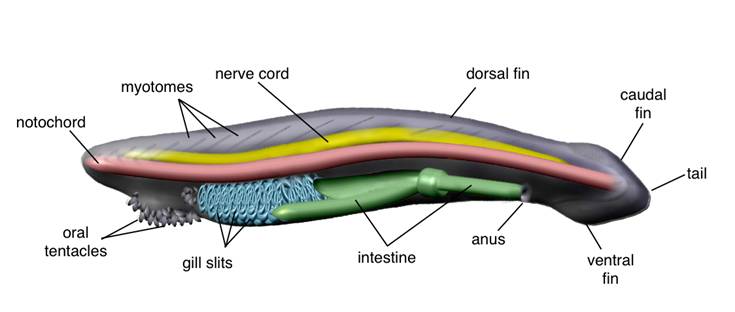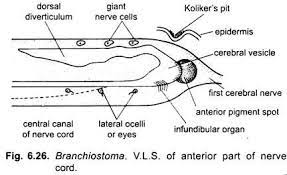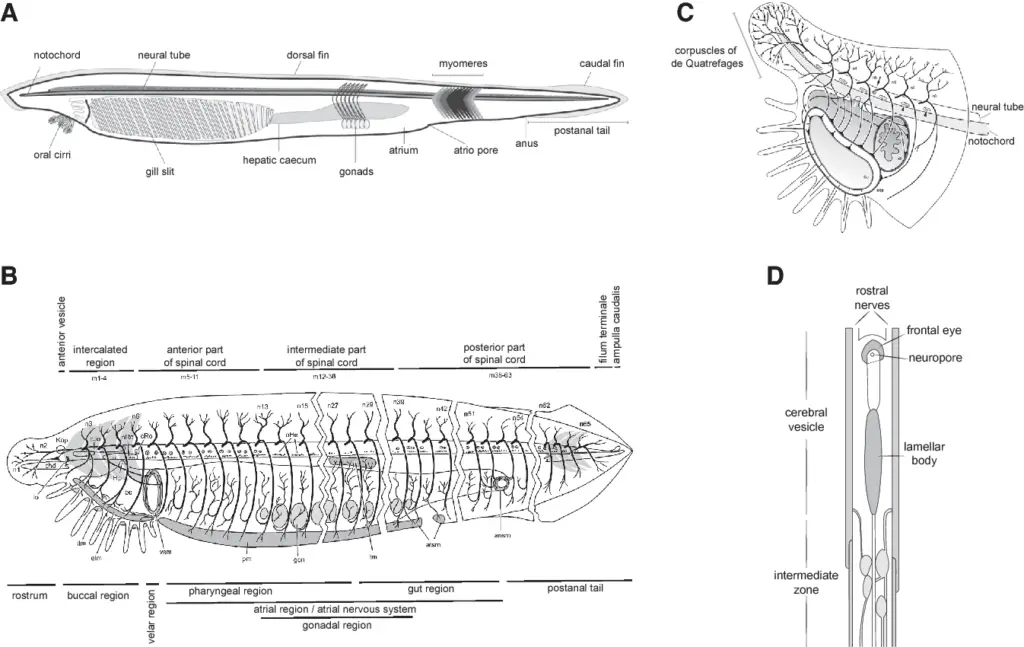In Branchiostoma nervous system is very simple with a dorsal nerve cord, nerves, sense organs but there is no well-developed brain in Branchiostoma.
Table of Contents
Central Nervous System of Branchiostoma:
Branchiostoma does not have a proper brain, the hollow dorsal nerve cord or neural tube represents the central nervous system in Branchiostoma. In Branchiostoma the notochord extends up to the rostrum on the anterior side, the hollow nerve cord presents just above the notochord up to the rostrum but the end just behind the notochord.
The nerve cord is present mid-dorsally and has no nerve ganglion but a slightly enlarged portion is known as the so-called brain or cerebral vesicle. On the posterior part, the nerve cord becomes slender and finally ends just before the ending of the notochord. The posterior tapering part of the nerve cord is known as the spinal cord, a narrow lumen or canal present inside the nerve cord known as neurocoel. The neurocoel is filled with a fluid known as cerebrospinal fluid, in the cerebral vesicle, the neurocoel is wider and form a ventricle.

The roof of the ventricle of the cerebral vesicle has an extension on the dorsal side known as a dorsal diverticulum. On the anterior wall of the cerebral vesicle is a sense organ pigment spot and on the floor, it has another sense organ, the infundibular organ. The nerve cord of Branchiostoma has a great resemblance with the central nervous system of higher Chordate, the nerve cord has the grey matter of nerve cells and on the peripheral portion, it has the white matter of nerve fibers.
On the dorsal wall of the nerve cord, some giant nerve cells are present which take part in rapid perception and react during any emergency.
Peripheral Nervous System in Branchiostoma:
In Branchiostoma the nerve cord or central nervous system gives some branches in pairs which form the peripheral nervous system, both cerebral and spinal nerves present in them. The first pair of nerves that arise from the cerebral vesicle is sensory in nature, they are known as cerebral nerves.
The two cerebral nerves do not have ventral roots, the two cerebral nerves carry sensory nerve impulses from the oral hood, buccal cirri, and rostrum to the cerebral part of the nerve cord. The pairs of nerves that arise behind the first pair of nerves are all known as spinal nerves.
Each pair of spinal nerve arise from the lateral side of the spinal cord in each segment and each spinal nerve has both dorsal root and the ventral root. The dorsal root gives supply to the skin between the myotomes and they are both sensory and motor, they are mixed. The ventral root supply is opposite to the myotomes and the ventral root has several branches.
The nerve in Branchiostoma is not covered by myeline sethe while all advanced Chordata have myelinated nerves.
Autonomic Nervous System of Branchiostoma:
The autonomous nervous system controls the activities of involuntary muscle present in the gut in Branchiostoma. Two nerve plexus present in the wall of the gut form the autonomous nervous system which is controlled by the visceral nerve arise from the dorsal root of the spinal nerve on each segment.
Sense Organs in Branchiostoma:
Eye Spots:
On the ventrolateral side of the nerve cord, several sensory cells are presently known as eyespot or ocelli responsible for the perception of the light stimulus. The ocelli is a photoreceptor structure that helps Branchiostoma to make burrows and in swimming. An eyespot is made of two cells, on the outer side a pigment cell or melanocyte is present, on the inner side the photoreceptor cell is present which has a striated border, the photosensitive cell has fine nerve fibers which send information to the nerve cord.
Infundibular Organ:
It presents on the floor of the cerebral vesicle and has a group of columnar epithelium cells with a long fine thread-like structure. The function of the infundibular organ is not clear but some workers assume that it perceives the pressure inside the ventricle of the brain due to cerebrospinal fluid.

Cephalic Pigment Spot:
On the anterior wall of the cerebral vesicle, a pigment spot is present which protects the ocelli against the frontal stimulation of light. It is not photosensitive but some workers assume that it takes thermal stimulus.
Kollicker’s Pit:
It is a depression on the roof of the cerebral vesicle which takes part in the perception of olfactory stimulation.
Hatschek’s Groove:
The ciliated depression on the dorsal wall of the oral hood has Hatschek’s pit and Hatschek’s groove and they are sensory in nature but their actual function is unknown.
Sensory Cells and Papillae:
On the epidermis especially on the dorsal side, on velar tentacles, on buccal cirri, some sensory cells or papillae are present which take part in the perception of a chemical stimulus and tactile stimulation.
Free Nerve Endings:
In Branchiostoma the internal structure has free Nerve endings which also take part in the perception of different types of stimulus inside their body.

Reference
Detailed Information on
Characteristics Features of Subphylum Urochordata
Classification of Subphylum Urochordata
Examples of Subphylum Urochordata: Clavellina, Salpa, and Doliolum
Examples of Subphylum Urochordata
Branchiostoma Habitat and Geographical Distribution
External Morphology of Branchiostoma
Body Wall and Endoskeleton of Branchiostoma
Coelom and Movement in Branchiostoma
Digestive System of Branchiostoma
Digestion and Feeding Mechanism in Branchiostoma
Hi Everyone!!! Welcome to Imaluop. Imaluop always try to learn some new and he want to share to other people. Here we will try to learn various topics on Science, specially on Biological Sciences.
